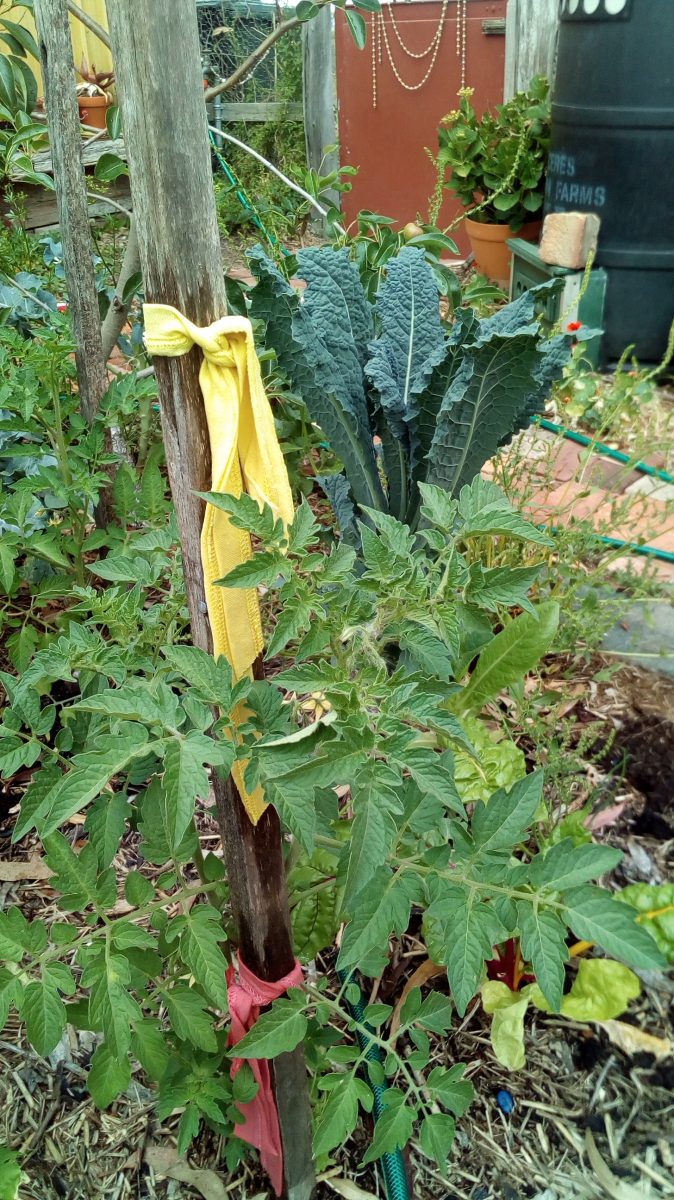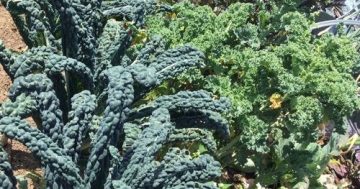
Recycled fishing net providing wind and sun shelter. Note the succulents in recycled guttering! Photos: Kathleen McCann.
Everything is so dry. We are now living (and some of our most beautiful plants and animals only just living!) in very difficult conditions across the Canberra region and South East NSW. What can we do to help keep our plants alive and our vegetable gardens healthy and hearty?
Here are a few go-to techniques and idea that have helped me ride out dry times.
First, where does your greywater go?
I’m doing the washing up in a plastic container that I then carry it to the garden when I’m finished. I bought an extender hose for the washing machine that reaches my vege patch and I put this mainly on the establishing fruit trees.
When I’m showering I stand in a big plastic carry tub that I then take out to the vege patch and delicately add it to some tomatoes and kale – two of the hardiest veg I’m growing so far.
They’re some easy, quick but laborious ways I use my greywater as a resource, but I’d encourage you to research converting your own system to a greywater resource hub. The internet is full of great ideas from simple low cost to the megabucks wizzy ones.
Those of you who have read my pieces in the past, you know my garden is heavily mulched. I also add a liquid feed to the greywater to give my plants a bit of a boost every couple of weeks, but they are still struggling because of one main thing – the wind!
My green vine wall of protection against wind has failed this year because it’s so dry.
I managed to pick up some wonderful heavy-duty old fish netting from Bermagui Wharf – it was being thrown out! I use that as a way to diffuse the wind. You may need to consider putting up and securely tying on shade cloth to help buffer those crazy winds – that are now becoming the norm all year round!

A precious peach protected from birds by a recycled avocado bag.
You must make sure though that the poles/fence you’re using is strong enough to cope with the added weight of the shade cloth in winds 30 km/h and above. You may need to shore up the poles with a brace.
You could consider investing or making wicking beds, a new trend that is becoming very popular.
Be sure you know what and where your soil and compost has come from as your plants will be turning that into food for you. Wicking beds are enormous self-watering pots, so they will take a bit of water to get going. I’m looking at putting my greywater from my tiny home into wicking beds. I’ve yet to figure that out how, but I’m sure the brains trust of Permaculture and the internet will hold the answers! I’ll let you know that outcome when it happens next year.
Consider letting some things go. I’m now just growing enough light greens like Perpetual Silverbeet and Oakleaf Lettuce for myself and the chickens.
My hardiest plants are the ‘Tommy Toe’ Tomato and Cavillo Nero Kale. I have Spring Onion and Parsley as my herbs. Because my fruit trees are still quite young they are struggling a little and have either lost or kept on only a few small fruits, precious things that I’m individually bagging against the birds. I have let the Rocket, some Parsley and Radish go to seed to keep the bees and butterflies happy. I do have hardy Salvias and Geraniums flowering so there is some colour in my garden.

Tommy Toe Tomato and Kale doing very well thank you.
Consider putting on more water tanks, even those of you in the urban areas. We now have to seriously think about not only our gardens but the extreme and disturbing proposition of fighting a fire, no matter where we live. One tank for household consumption, one tank for the food, one tank for firefighting.
It seems to be a time of resting in the garden, riding out and conserving energy while we wait for the rains to come. At my place most of my garden is ‘resting’, lying fertilised and fallow, ready to be planted when I know our tanks will be full again.
Stay hydrated my friends!
Kathleen McCann is a permaculturalist, artist, good chick, number 1 worker at Luscious Landscapes.
Original Article published on About Regional.





















